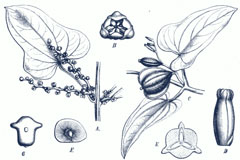Plant Portrait - Dioscorea batatas - The Hardy Yam

Most people think of yams as being tropical plants, and therefore unsuitable for cultivation in this country. However, there are a very few species that come from temperate zones and will thrive here. This particular species comes from the mountains of northern Japan and can tolerate temperatures down to about -20°c - it can, therefore, be grown outdoors in most parts of the country.
The plant is a vigorous twining herbaceous climber. It can send out shoots up to 3 metres long each year and these will need supporting. You can grow it like runner beans up a frame or bamboo sticks. It is also possible that this plant will do well on a sunny woodland edge, allowing its shoots to scramble into the branches of shrubs. The main problem here is that harvesting the root is going to cause a lot of disturbance to the other plant roots.
This is a very easily grown plant that succeeds in most fertile well-drained soils. It prefers a position in full sun, though it will also succeed in semi-shade.
 The edible root can be up to 1 metre long and weigh 2 kilos or more if it is grown in a good deep soil. It is the shape of a club, about as thick as an adult's finger at its top it thickens to be the size of their arm at its base. The main problem with this plant is harvesting it, you have to dig deep! Once you get it out, the root has a very nice flavour with a floury texture when baked, it is not as tasty as a sweet potato but is better than most yams and superior to potatoes. It makes an excellent staple food and, since yams are now becoming a more common food in Britain, it has a very good potential as a commercial crop here. What is needed is a simple method of harvesting the root.
The edible root can be up to 1 metre long and weigh 2 kilos or more if it is grown in a good deep soil. It is the shape of a club, about as thick as an adult's finger at its top it thickens to be the size of their arm at its base. The main problem with this plant is harvesting it, you have to dig deep! Once you get it out, the root has a very nice flavour with a floury texture when baked, it is not as tasty as a sweet potato but is better than most yams and superior to potatoes. It makes an excellent staple food and, since yams are now becoming a more common food in Britain, it has a very good potential as a commercial crop here. What is needed is a simple method of harvesting the root.
The tubers can be boiled, baked, fried, mashed, grated and added to soups. They store well and for a long time, and can also be left in the ground and harvested as required in the winter. They contain about 20% starch. 75% water, 0.1% vitamin B1, 10 - 15 mg % vitamin C.
Because yams produce a very vertical root, it is possible to grow a number of plants very close to each other, perhaps at 20 - 30cm spacing. You also get a better overall yield if you leave the plants in the ground for two years. Exceedingly high yields are possible, certainly quite a bit higher than potatoes and with none of the disease problems associated with that plant.
Yam tubers are used medicinally in China and Japan. They are seen as a sweet soothing herb that stimulates the stomach and spleen and has a tonic effect on the lungs and kidneys. The tuber contains allantoin, a cell-proliferant that speeds the healing process. It is used internally in the treatment of poor appetite, chronic diarrhoea, asthma, dry coughs, frequent or uncontrollable urination, diabetes and emotional instability. It is applied externally to ulcers, boils and abscesses. The tubers are harvested in the autumn and can be used raw or baked.
Propagation is a simple matter. Cut off the top 15cm of the root (this is the thin bit, so it is less useful for eating), store it cool and dry for the winter and then replant it in early spring. Do not remove this top portion until you want to eat the yam, though, because it will store much better in one piece.
Yams also form tubercles in late summer and early autumn. These are pea-size swellings in the leaf axils and they fall off the plant when they are ripe. These tubercles are actually baby tubers and are an excellent way of propagating a quantity of the plants. Try and harvest them just before they are ready to fall from the plant and store them in a cool, frost-free place over the winter. Make sure they do not dry out. Pot them up into individual pots in early spring and plant them out when in active growth. They will form tubers about 500 grams in weight their first year, if left in the ground this can increase to 2 kilos or more in their second year.
We have been growing yams for a number of years and thoroughly enjoy eating the roots. The plants have not been entirely happy with us, however, because they do not like our windy site. However, as the tree shelter has increased over the past couple of years we have at last been able to increase our stocks. There are many named varieties in China and Japan, though these are not yet available in this country.
Database
The database has more details on these plants: Dioscorea batatas.
image attribution: commons.wikimedia.org, flickr.com/photos/tckbrz